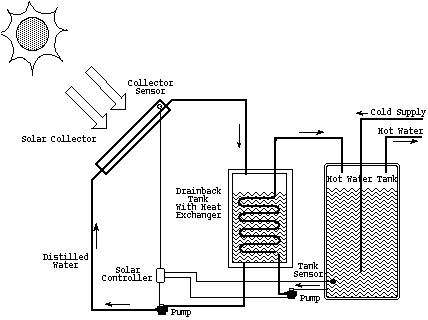You don’t need to live in the tropics to heat your water with solar energy. Any sunlight will do. Different situations and climates need different types of solar water systems. There are some websites at the end of this story to help assess which suits you the best.
Solar water heaters like solar energy systems can be expensive to start up, but cost little to maintain. You generally get pay-back after a few years. They’re a sustainable source of cheap, environment friendly energy.
In the UK, grants and discounts towards the costs of solar water heating systems are available from local or national organizations. For example the Clear Skies program, gives homeowners a 400 grant. In the USA tax incentives and grants depend on the state you live in.
For more efficient solar energy, weatherize and insulate your home and water: this will save you energy. Its obvious but worth repeating, place your solar collectors in a sunny spot on your house. Ideally, face south and be tilted at a 30 degree angle.
You’ll find two different types of water heating systems: active and passive systems.
Active solar water heating systems are the most common systems on the market. They are made up of collectors, usually flat solar panels, to capture solar energy; a circulation system to move fluid between the collectors to a storage tank; a storage tank; a backup heating system and a control system to regulate the overall system operation.
There are two basic categories direct, or open loop, systems and indirect, or closed loop systems. The most widely used of all system is the drain back indirect system. It is at the same time efficient and reliable and requires little maintenance. Basically, fluid circulates through the collectors and is heated up by the sun. The heat from this fluid is then transferred to water running through the collector via a heat exchanger: a device placed on a wall inside the collector, separating the fluid from the water.

For an example of active solar water heater on the market see www.solartwin.com
You shouldn�t rely exclusively on solar heated water. A well designed system will only provide 50 to 80% of a home’s hot water needs, depending on the season. On average you should make sure that you plan 10 to 15 square feet (about 1.5 square meter) of solar collector area for each person living in the house. The storage tank should be big enough to hold 20-30 gallons per person.
Everyone has experienced water heated by a passive solar heater, for example a hose that had been lying in the sun for hours.In passive water heating systems the house water circulates through a solar collector before it is stored or sent to the point of use. The simplest of all solar water heating systems is the batch passive system. It consists of one or more metal water tanks painted black to absorb heat and placed in an insulating box exposed to direct sunlight. Water moves through the system every time a tap is opened, hot water leaves and is replaced by incoming cold water.
See www.solardirect.com
Links
For professional assistance in the USA
www.solarenergy.org
in the UK www.greenenergy.org.uk
www.solarcentury.co.uk
For a directory of solar system retailers world wide
www.ecobusinesslinks.com
For more information
The Sustainable Building Guidebook

3 Responses
There are need being felt for Solar base Captive Power Plant further supported by Bio-mass. At the same time Collector needed for the Industries having Temp. limitations up to 110.C
There are need being felt for Solar base Captive Power Plant further supported by Bio-mass. At the same time Collector needed for the Industries having Temp. limitations up to 110.C
In Germany, hydronic homes heating systems are built to use solar heated water in conjunction with geothermal heat pumps and gas furnace systems. Thus, if there is not enough solar hot water for heating the home, the heating system automatically starts the geothermal heat pump system to enhance the solar hot water. If both systems are not providing adequate hot water, the heating system automatically starts a gas fired hot water heating system.
solar Water Heaters:
http://www.thermotechs.com, http://www.solargenix.com, http://www.heliodyne.com, http://www.powertech-solar.com, http://www.sundasolar.com, http://www.sharadainventions.com, http://www.solarthermal.com, http://www.solarroofs.com, http://www.solartwin.com, http://www.suntek.com.tw, http://www.sudarshansaur.com, http://www.acrosolarlasers.com, http://www.thermocell.co.nz, http://www.omsolar.com, http://www.solar-tube.com, http://www.solartechnikberater.de, http://www.thermocell.co.nz, http://www.celciussolar.com, http://www.solarenergy.com, http://www.solarbridge.com, http://www.ga2020.com, http://www.microsolarsystem.com, http://www.sunmax.nu, http://www.solar-components.com, http://www.sgaenergy.com, http://www.thermo-dynamics.com;
solar Pool Heaters:
http://www.thermotechs.com, http://www.heliodyne.com, http://www.focus-solar.com, http://www.fafco.com, http://www.enersol.com, http://www.freeheat.com.au, http://www.heliocol.com;
hydronic home heating using solar heated water:
http://www.escosolar.com, http://www.solar.org.uk, http://www.wirsbo.ca, http://www.thermotechs.com, http://www.radiantcompany.com, http://www.heliodyne.com, http://www.twapanels.ca, http://www.roth-usa.com, http://www.h2ohtg.com/Stadler, http://www.infloor.com, http://www.spnwsupply.com, http://www.solartech-uk.co.uk;